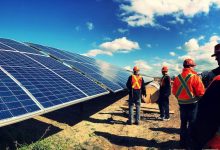There has been a huge amount of interest in the new assessment of marginal loss factors – both in the final decision made by the Australian Energy Market Operator that we reported on Monday, and in the fascinating animated gif that highlighted the changes across the country in the last decade.
MLFs may be based around obscure algorithms but they are critically important. A big downgrade – as some wind and solar farms have discovered – means a lot less revenue, and some projects now may only get credit for 75 per cent of their output.
To throw yet more light on what’s going on, here’s another illustrative graph by the same people who brought us the animated gif, the project management firm Ekistica.
It shows the changes in MLFs over the past decade by technology, and it shows one clear trend – the gradual spike upwards in MLFs for the solar industry and the sharp plunge in the last two years for the same technology.
It’s pretty clear what has happened here. At first solar farms were installed in areas sparsely populated with generators, filling in the gaps and benefiting with high MLFs of above 1.0 (meaning they got a premium rather than a discount).
But then too many solar farms were built in the same areas, causing congestion on the grid. The average MLF for solar farms is now just above 0.9, meaning that nearly 10 per cent of their output is not credited.
As Ekistica’s Lyndon Frearson notes, so many solar projects located themselves at points of high MLF that they have effectively eaten their own lunch, and cannibalised their market.
Or, as AEMO noted in its final assessment of MLFs: “With increased generation connections of the same technology in an area, a daily pattern is observed due to increased supply and low demand during daylight hours. As a result, MLFs in these areas are declining sharply.”
AEMO provided this graph above as an example.
The trend for other generation technologies (see the top graph) is pretty consistent, probably because they were either closer to load or had more geographic or production diversity. The MLFs of all three other technologies – fossil fuel, wind and hydro – have also fallen in the last year, but more gradually than solar.
The MLF factor is probably the major blight on the copy-book of the solar boom, which is rapidly changing the shape of the Australia grid, as we reported here in some detail.
 Large scale solar is now contributing more than five per cent of the main grid’s operational demand, and this graph above highlights how this share has grown significantly over the last 12 months – the difference between the red and dark lines – and will grow further as yet more projects (more than 3,000MW) are added to the grid in the coming 12 months.
Large scale solar is now contributing more than five per cent of the main grid’s operational demand, and this graph above highlights how this share has grown significantly over the last 12 months – the difference between the red and dark lines – and will grow further as yet more projects (more than 3,000MW) are added to the grid in the coming 12 months.
The greatest share of large scale solar occurs in South Australia (on average more than 8 per ent of operational demand at midday) and this will grow as more solar farms are included (the newly complete 95MW Tailem Bend and the yet to be complete 110MW Bungala 2), among others such as the 280MW Cultana plant.
Interestingly, the graph above shows a flatter profile for Victoria, which AEMO attributes to the greater share of single axis tracking technology in that state.
There is plenty of criticism about the way MLFs are structured in Australia and the rules that apply. AEMO itself admits that there must be a better solution and it is working to find one to provide clarity and certainty to developers of wind and solar projects.
Mostly, it wants to be able to get on with its Integrated System Plan, which it says provides a blueprint for the transition of the grid to a renewables dominated system, and will unlock some of the current blockages.
AEMO is updating that ISP, and was due to outline the various scenarios it would incorporate in its planning – including, at the urging of many of the big utilities and lobby groups, a “step change” scenario that factors in early closures of remaining coal plants, a more rapid uptake of wind and solar, and a serious assessment of what is needed to meet Paris target’s 1.5°C target.
That scenario planning was due to be released this week. However, perhaps given the sensitivity of the issue and the election on Saturday, a spokesman for AEMO said no announcements would be made this week.












